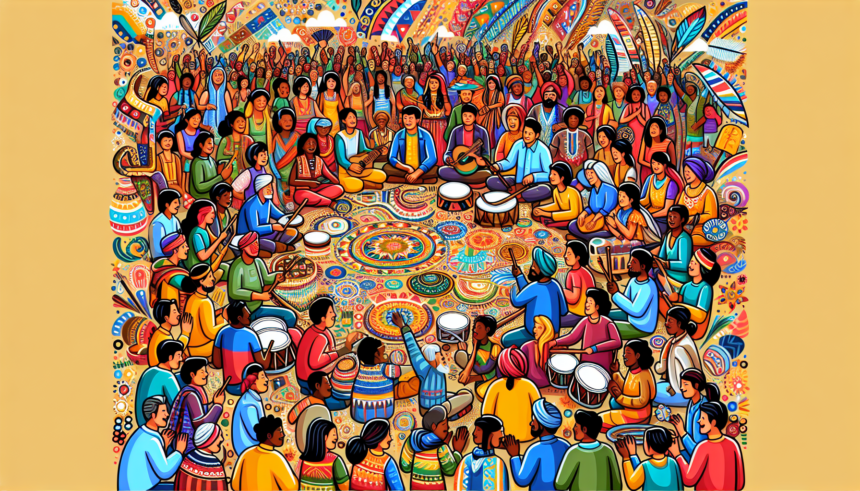Nestled in a remote part of the world, the Pan Tribe is a community that prides itself on its strong cultural
heritage and deeply rooted traditions. This tribe has thrived for generations, preserving and celebrating its
customs through various festive gatherings that draw members from near and far. The annual Pan Tribe Gathering,
in particular, stands as a beacon of their rich communal life and offers a glimpse into an extraordinary way of
life. This article delves into the captivating world of the Pan Tribe, shedding light on the cultural and communal
aspects that define their gathering.
The Pan Tribe: A Brief Introduction
The Pan Tribe is located in a lush area surrounded by nature, providing an ideal backdrop for their way of life.
With a population of approximately 2,000 members, the tribe operates on a social structure deeply interconnected by
family ties and community bonds. The Pan people speak a unique language and practice a variety of traditions and
rituals that have been passed down through generations.
One of the most distinctive characteristics of the Pan Tribe is their emphasis on communal living. Individual
success is often measured by one’s contribution to the community rather than personal achievements. Sharing
resources, supporting one another in times of need, and celebrating together form the core of Pan Tribe’s ethos.
The Annual Gathering: A Celebration of Unity and Culture
The annual Pan Tribe Gathering is a significant event that embodies the essence of their community and cultural
identity. Held every year in the early spring, this gathering attracts all tribe members, marking it as one of the
most anticipated events of the year. The celebration spans three days and is marked by a plethora of activities,
including traditional dances, music, food sharing, and various rituals.
Preparations for the gathering begin months in advance. Each family is assigned specific roles, such as preparing
certain types of food, crafting traditional garments, or arranging decorations. This collaborative effort
reinforces the sense of community and ensures that everyone has a role to play in the celebration. As the gathering
approaches, excitement builds across the tribe, with everyone looking forward to reconnecting with distant
relatives and strengthening communal ties.
Traditional Dances and Music
Music and dance are integral components of the Pan Tribe Gathering. These art forms serve not only as entertainment
but also as a means of storytelling and preserving the tribe’s history. Traditional dances performed during the
gathering are often choreographed to depict significant events, myths, and legends that have shaped the Pan Tribe.
The music accompanying these dances typically involves a combination of drums, flutes, and string instruments. The
rhythms and melodies are passed down through generations, with each family contributing to the preservation of
these musical traditions. For many tribe members, participating in these dances is a way of connecting with their
ancestors and keeping their cultural heritage alive.
Rituals and Ceremonies
Rituals and ceremonies are at the heart of the Pan Tribe’s annual gathering. These rituals are rooted in the tribe’s
spiritual beliefs and are performed to honor their ancestors, seek blessings for the future, and reinforce
communal bonds. One of the most important ceremonies is the “Circle of Ancestors,” where tribe members gather in a
large circle, light candles, and share stories about their forebears.
Another notable ritual is the “Offering of the Harvest,” during which the tribe presents the best of their harvest
to the spirits. This ritual is a way of expressing gratitude for the abundance of resources and seeking continued
prosperity. The offerings are carefully prepared and presented with chants and prayers, creating a powerful and
reverent atmosphere.
Food: A Culinary Celebration
Food plays a central role in the Pan Tribe Gathering, symbolizing not only sustenance but also the joy of sharing
and togetherness. The feast prepared for the gathering showcases a variety of traditional dishes made from locally
sourced ingredients. Each dish is prepared with great care, following recipes that have been handed down through
generations.
One of the highlights of the feast is the communal preparation and consumption of “Pan Bread,” a traditional bread
baked in large clay ovens. The process of making Pan Bread is a collective effort, with tribe members of all ages
participating. The bread is then shared among everyone, reinforcing the values of community and shared sustenance.
Workshops and Skill Sharing
In addition to the cultural festivities, the Pan Tribe Gathering also features workshops and skill-sharing sessions.
These workshops cover a wide range of topics, from traditional crafts and herbal medicine to storytelling and
environmental conservation. Elders and knowledgeable tribe members lead these sessions, passing on their expertise
to younger generations.
These workshops serve as a platform for the tribe to share knowledge, preserve their traditional skills, and ensure
that their cultural heritage is carried forward. For many participants, these sessions are a highlight of the
gathering, offering a valuable opportunity to learn and connect with their cultural roots.
Conclusion
The Pan Tribe Gathering is a remarkable testament to the strength of community and the power of cultural traditions.
Through music, dance, rituals, food, and skill-sharing, the gathering brings the tribe together in a celebration of
unity and cultural heritage. It is a time for reconnecting with loved ones, honoring the past, and looking forward
to the future. The gathering not only reinforces the communal bonds that define the Pan Tribe but also serves as a
powerful reminder of the importance of preserving and celebrating one’s cultural identity.
FAQs
1. What is the significance of the Pan Tribe Gathering?
The Pan Tribe Gathering is significant as it serves as a celebration of the tribe’s unity, cultural heritage, and
communal bonds. It is an opportunity for tribe members to reconnect, honor their ancestors, and participate in
traditional activities that reinforce their cultural identity.
2. How do the Pan Tribe members prepare for the gathering?
Preparations for the gathering begin months in advance, with each family assigned specific roles such as preparing
food, crafting garments, and arranging decorations. This collective effort ensures that everyone has a role to play
and reinforces the sense of community.
3. What types of traditional dances and music are performed during the gathering?
Traditional dances performed during the gathering often depict significant events, myths, and legends of the Pan
Tribe. The accompanying music typically involves drums, flutes, and string instruments, with rhythms and melodies
passed down through generations.
4. What are some of the key rituals and ceremonies at the gathering?
Key rituals include the “Circle of Ancestors,” where tribe members share stories about their forebears, and the
“Offering of the Harvest,” where the best of the harvest is presented to the spirits in a show of gratitude and
reverence.
5. How does the Pan Tribe Gathering help in preserving cultural heritage?
The gathering helps preserve cultural heritage by providing a platform for traditional activities such as dances,
music, rituals, food preparation, and skill-sharing workshops. These activities ensure that cultural knowledge and
traditions are passed down through generations, reinforcing the tribe’s cultural identity.





